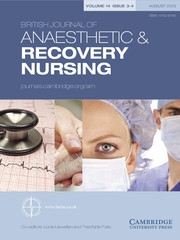Article contents
Parental Presence within the Post-Anaesthetic Care Unit
Published online by Cambridge University Press: 25 February 2009
Abstract
As health care providers our philosophy is to deliver the very highest quality of care to our patients. However within many hospitals there are not firm policies to allow family members to see their loved ones in the immediate postoperative period. Thus parents are routinely not being encouraged to comfort and support their children within the Post Anaesthetic Care Unit. The evolution of ‘family centred’ care should result in parents being encouraged to be with and care for their children during hospitalisation. This has been found to be beneficial to all parties. Whilst parental presence in the anaesthetic room has become more accepted practice the same cannot be said of Post Anaesthetic Care Units despite the recommendations made by the Department of Health [1991] and ‘The Patients’ Charter [1996]. Why does this situation exist? Is it due to preconceived attitudes of the staff involved, parental ignorance or historical reasons? This article will examine available research and attempt to identify possible reasons why such situations exist within many Post Anaesthetic Care Units and suggest possible solutions.
- Type
- Research Article
- Information
- Copyright
- Copyright © British Association of Anaesthetic and Recovery Nursing 2002
References
- 1
- Cited by


